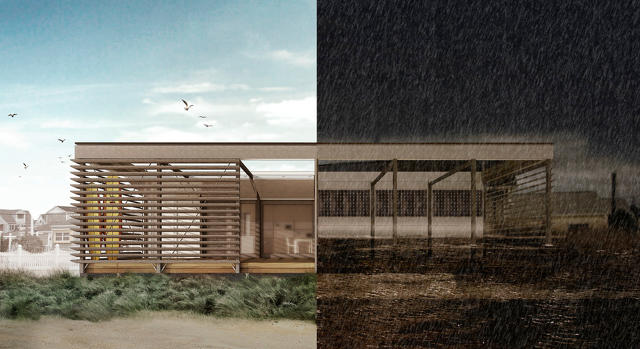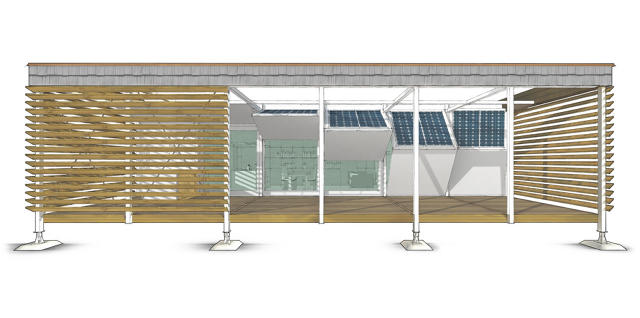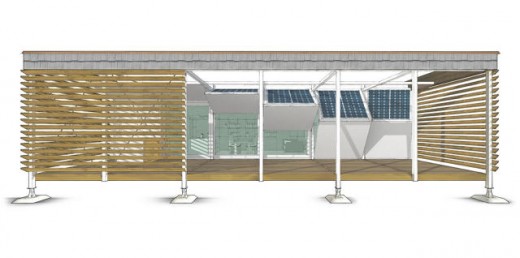This New student-Designed super-Resilient house is The seashore home Of The Flooded Future
We wish to redesign our coastal housing for stormier days in advance, and it will seem something like this.
August 12, 2015
When hurricane Sandy hit in 2012, waters flooded over Hoboken, New Jersey, a commuter city throughout the Hudson River from midtown ny. With half town stranded, the national protect moved in with meals and supplies. throughout New Jersey, the storm destroyed 350,000 homes.
Three years later, a 60-particular person staff of Hoboken college students is assembling an excellent new resilient house that’s designed to face up to the next storm Sandy-like storm and even provide energy to its neighbors in a catastrophe. When they are finished, they’ll ship it to Seaside Park, a Jersey shore seaside neighborhood, the place it’ll function a resilience schooling heart.

“it all started with: ‘How can we intellectually respond to typhoon Sandy?” says architect John Nastasi, an teacher on the local Stevens Institute of technology. “Being an engineering institution, we wanted to actively engage with the neighborhood.”
After more than two years of labor, including interviews with many Jersey shore residents, the result is the positive house (assume SUstainability + REsilience). the house serves as the college’s entry into the 2015 sunlight Decathlon, a biennial national competition sponsored through the U.S. department of energy that challenges college groups to design and construct attractive, revolutionary sun-powered houses.
Designed with the open format of a seaside cottage, the house is armored in opposition to extreme weather and uses ninety% less energy than the average residence of its dimension. What little energy it does devour is, of course, powered with the aid of the rugged sunlight cells on the roof. With the excess energy it generates, it can power an electric car or allow neighbors to plug in batteries if power goes out.

“basically we’ve created an air tight bubble,” says development supervisor Chris Hamm, a 23-year-old Stevens graduate student in product architecture and engineering. the home is designed to be a passive home, an ultra-low energy constructing same old that used to be first developed in Germany and is changing into more and more common within the U.S.
sure home’s enormous sliding windows—which would in most cases leak lots of power—are actually three layers of 600 kilos of glass that seal into the body. combating air from escaping shouldn’t be only energy efficient, but it surely provides higher storm resiliency. Many standard seashore houses that use fiberglass insulation to keep warmth inside had to be gutted due to water injury. “We’re ten times more airtight than a regular dwelling,” Hamm says.
overall, the house is also designed to be extremely resilient in as much as 5 toes of storm floods and one hundred thirty mph winds. inspired by way of some elements of boat design, the resilience begins within the total constructions and is evident in many small print. In a storm, for example, huge multi-goal shutters can also be pulled down over the wall-sized home windows to give protection to from waters and winds. however all the way through standard instances, the shutters may also be opened onto a assisting body that creates a shaded, power-saving porch. The porch is made from a percentand bamboo composite that appears like wooden, however is a lot better at withstanding water and salt water air corrosion.

after all, the house isn’t totally in reach but for most Jersey shore residents. It costs the students $350,000 to build, towards an overall project finances of $2 million—all of which the scholars lift or in finding sponsorships to fund. The latter prices embody shipping the house to and from California, the place it’s going to compete in September towards sixteen other properties on this 12 months’s sun Decathlon contest, a department of energy-subsidized contest pupil design contest for sunlight-powered homes. After, the plan is to send it to Seaside Park, where universities will companion to be involved in endured analysis and public training.
the scholars hope the story round their home helps within the competitors, even if storm resiliency shouldn’t be a part of the judging standards. Says AJ Elliott, another graduate scholar best the project: “constructing something sustainable is great, but when you’re constructing something that’s going to get wiped out by the next storm, what’s the purpose?”
(125)














